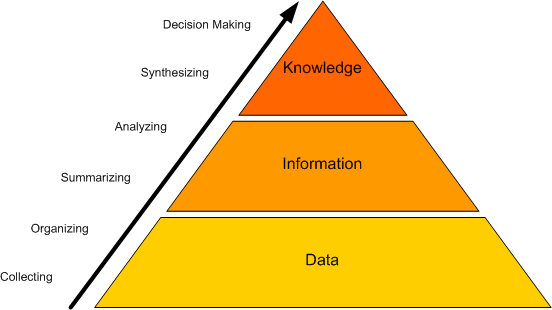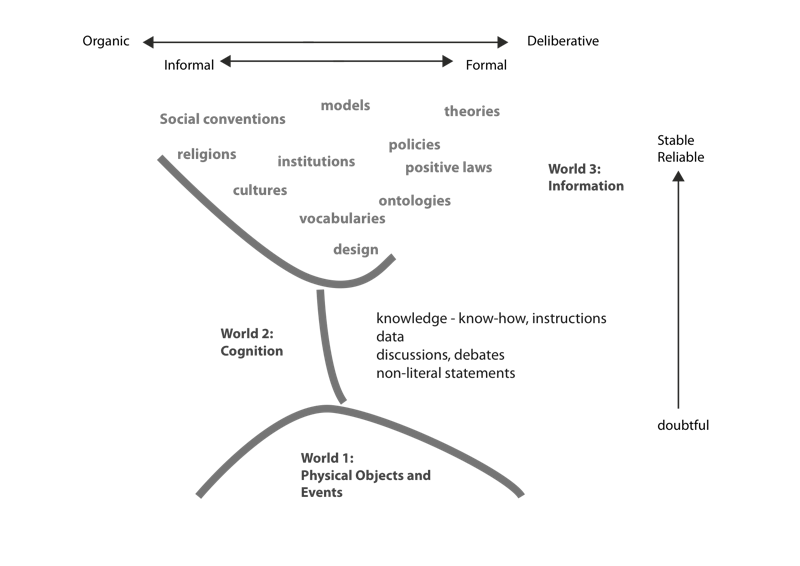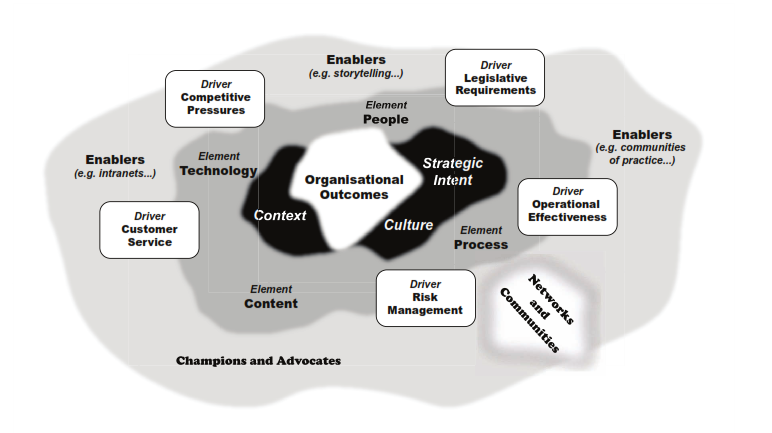Executive Summary
The Institute for Information Management has been committed to achieving its vision of becoming the leading provider of information to various companies within Australia. However, its system is falling apart because of its inability to address some of the strategic issues affecting various industries.
Not only is it losing the companies that were formerly its members, but also the volunteers who now consider it ineffective in addressing their career development needs. In order to address this problem, the institute will need to apply the concept of knowledge management system.
Introduction
Knowledge management system has become very important for organisations in an environment where information is an important tool in achieving success. Both profitable and non-profitable organisations experience some form of challenges that force them to improve their service delivery in order to remain efficient in their operations.
To achieve the desired success, they need to have a proper knowledge management system that will allow all the departments to share relevant information within the shortest period possible. Lambe (2011, p. 185) defines knowledge management system as “A system that helps the organisations in creation, capture, processing, storage, and dissemination of information.”
The system enables organisations to improve their efficiency in processing relevant information and transmitting it to the relevant departments and individuals so that it may define their decisions as a way of improving their efficiency.
Wilson (2002, p. 86) says, “The idea of a knowledge management system is to enable employees to have ready access to the organisation’s documented base of facts, sources of information, and solutions.” This way, they will always make informed choices based on the information in the system. It also eliminates bureaucracy that exists in some organisations that limits information sharing.
The Institute for Information Management has remained committed to its aim of becoming the leading source of information management for companies in Australia. However, it has been faced with numerous challenges which make this vision to be elusive.
This research seeks to find ways though which this institute can use the knowledge management system to promote engagement and collaboration among its members in order to improve its service delivery and attract more volunteers.
The Case Study
The Institute for Information Management has worked tirelessly to gain relevance as one of the leading organisations that brings together users of information management systems and the providers of the enabling technologies in a forum where they can share relevant information in this field.
It has massively contributed to the effective development of information management system in this country by disseminating information management industry trends, opportunities, and accomplishments. However, this organisation is currently facing a problem in an industry that it expected to achieve success.
The number of volunteers to the organisation is drastically dropping, and so is the number of those who are regularly using its services. It means that something is wrong with this organisation in terms of the approach it takes in managing its processes.
It must have failed to appeal to the volunteers, and this explains why their number at this organisation has been declining over the years.
This has largely been blamed on its fundamental model of membership. This organisation needs a model that will enable it to engage its members with the view of promoting collaboration when addressing various tasks. It is necessary to find the best ways of applying knowledge management system in order to address this problem.
Knowledge System behind Micro-Volunteering at the Institute for Information Management
According to Serenko and Bontis (2013, p. 310), over 6 million Australians always volunteer to work in different sectors as a way of making a difference in this country. Some people offer to volunteer as a way of meeting new people or trying something new, while others do it as way of improving their careers. Irrespective of the reasons why people volunteer to work in various organisations, the fact is that they always want something new.
They want a working environment that would add a difference to their life. This is what is lacking at this institute, making its membership to decline. The Institute for Information Management must realise that its members need a system that will make them aware of the changing industry trends, and other relevant issues that may make them be informed about their respective industries.
The first step that it should take in addressing its current process is to develop a model that will improve its efficiency in collecting data about the changing trends in the relevant industries it has chosen. This will enable it to become a superior platform through which users of information management systems and the providers of the assistive technologies can interact and achieve their respective goals.
According to Dalkir (2011, p. 59), this can be done by developing a knowledge management model that will be beneficial to all the stakeholders. The knowledge management cycle below is one of the most appropriate models that this firm should consider using.
Knowledge Management Cycle

Source: (Walsham 2001, p. 610).
The model will be able to capture, organise and make accessible all the relevant information about various fields for the benefit of the stakeholders. It will also enable the stakeholders use the information to learn through creation and sharing of the relevant data on various fields.
This institute must realise that most of the volunteers’ aim is to improve their capacity to understand the changing trends in various fields so that they can make a positive difference in their companies at a later date. They must feel that this institution is offering them the opportunity to be well informed.
Interventions designed to improve the situation
It is clear that the Institute for Information Management needs to find ways of improving its system, especially its capacity to capture the changing trends in various fields in order to attract volunteers and other stakeholders. The users of information need an organisation that has the right information about different industries in which they operate.
They also need to know about various knowledge management products, their superiority over the other existing systems, and the most reliable vendors. The vendors are interested in institutions that can sell them to the information users and give the right knowledge about the products they offer.
The volunteers need to be assured that for the time they will be with the organisation, they will always have the first hand information about the changing trends in the market in their respective industries.
This means that the management at this institution needs to have a top notch system that can enable it to collect, synthesises, and disseminate information to its members within the shortest period possible. The following knowledge management pyramid shows the steps that should be followed.

Source: (AlSondos & Othman 2012, p. 275).
As shown in the pyramid, the system should allow for an efficient collection and organisation of the data. The collected data should be summarised and then analysed to give the clear information about a specific issue. The information will then be synthesised into useful information. All the members should then be provided with the knowledge in order to define their decision making process (Resnick 2004, p. 84).
It is important at this stage to state that the knowledge should not only be used by the management to improve its operations. The users of the information, which may be companies, also need to be provided with the knowledge prepared in the same manner about the trends in their respective industries.
It would be important to design a model that this institute needs to use in order to address the problem that is currently affecting its operations.
Suitable Knowledge Management Models to Apply in the Case
It would be important for the Institute for Information Management to find an appropriate model that it can use to address its current problems. The volunteers need to be assured that this institute will help them in advancing their careers.
Other stakeholders also need to ensure that their interests will be protected when they are members of this institute. This institute needs to have a cyclic approach to managing information. The following diagram shows a model that this institution should use to ensure that it always provides up to date knowledge to its members.
Popper’s 3 World Model

Source: (Buckman 2004, p. 39).
Popper’s 3 World Model is one of the best knowledge management models that organisations are currently using in order to ensure that they meet their expectations. When using this model, the institute needs to know the specific needs of its stakeholders in order to ensure that the results yielded is what they expect.
According to Dawson (2000, p. 96), world 1 is defined by the physical environment which includes the objects and events that have a direct impact on an organisation. When addressing this physical environment, the institute needs to ensure that it has the right employees that will earn it a good reputation within the country. It may need to contract some of the best professionals in various fields to be part of its team.
To the volunteers, they desire to work alongside these talented professionals in order to advance their careers. To the information users, they would want to associate themselves with this institute when they realise that they have a team of experts that may help them in their fields.
They will believe that through these experts, they will not only get to know about the industry trends but also the most reliable vendors of the relevant assistive technologies. This will put this firm on its path towards growth.
In world 2, there are cognitive processes that involve creativity, intelligence, and other mental skills that can enable a firm do something differently. As an institute of knowledge management, this organisation will have to be creative enough to be of relevance to the stakeholders. It should be the driving force to the emerging trends in various industries.
The professionals and volunteers should come together to create new approaches of addressing various issues in various industries in a way that would address some of their current problems. Every company would want to associate with an enterprising institution that can help them overcome some of their challenges. This is what the institute should offer to its clients in order to retain them.
According to AlSondos and Othman (2012, p. 291) “Third world involves the semantic world of information comprising data, statements and articulated knowledge.” It also involves the knowledge earned through experience. At this institution, it would be appropriate to find ways through which these organisation members can share their experiences as a way of finding a common solution to a common problem.
As Wilson (2002, p.75) says, sometimes it may be necessary for rivals to come together in order to score against a common enemy. The institute should provide the best platform through which competitive firms can come together and share tacit knowledge about various issues in the industry.
Intellectual capital that needs to be managed
It would be vital for this institute to understand the intellectual capital that the stakeholders trust it with. This organisation should ensure that it protects the trust it has with its clients. Some of the information users may come to it for the purpose of consultancy. When this happens, they may reveal some of their classified information.
This information should remain confidential as an intellectual capital of that particular organisation. The institute will also need to identify some of the existing knowledge assets that may form part of the new system that is being developed.
This may include the past information that still remains relevant in the current context. The candidate techniques for intervention at this institute include the process of identifying its strategic partners, information processing strategies, and the strategy it is using to maintain creativity in its operations.
Proposed Knowledge Management System
In order for the institute to achieve its vision in this industry, it will need a knowledge management system that will enable it to understand the environmental forces and act upon them within the shortest time possible. Using knowledge management system will enable this firm to identify the enablers, drivers, and elements of change.
Knowledge Ecosystem

Source: (AlSondos & Othman 2012, p. 272)
This system will require the management to conduct a regular research about the changing environmental patterns in various areas of management. To achieve this, a team of experts in the fields like marketing, production, and finance among other fields may be needed.
Also necessary will be the technological infrastructure such as computer system and databases to enhance the process of data collection, processing and sharing of the knowledge. The institute may also need to readjust its policy, procedures, and attitudes towards the volunteers to stop their number from dropping. An increase in its membership will be the clear information that its intervention has produced some benefits.
Conclusion and Recommendations
The Institute for Information Management’s vision of becoming the definitive Australian industry source of information may forever remain a dream if the current problems are not addressed.
It has been losing its clients and volunteers who feel that they are not getting what they expected from the organisation. In order to reverse its current negative trend, this institute needs to embrace knowledge management system and some of the models it has to offer. The following recommendations should be observed.
- The Institute for Information Management should introduce knowledge management system models into its operations.
- The first step to address the declining membership will be to hire the renowned professionals in various fields to attract the volunteers, information users, and system vendors.
- The management should embrace a cyclic approach to obtaining, processing, and disseminating information to ensure that it remains updated in its operations.
- The institute should remain innovative, especially when addressing the problem brought about by the emerging trends.
List of References
AlSondos, I & Othman, F 2012, Requirement for Knowledge Management System, Journal of Communication and Computer, vol. 6. no. 11, pp. 263-275.
Buckman, R 2004, Building a knowledge-driven organisation, McGraw-Hill, New York.
Dalkir, K 2011, Knowledge management in theory and practice, MIT Press, Cambridge.
Dawson, R 2000. Developing Knowledge-Based Client Relationships: The Future of Professional Services, Cengage, New York.
Lambe, P 2011, The unacknowledged parentage of knowledge management, Journal of Knowledge Management, vol. 15. no. 2, pp. 175-197.
Resnick, M 2004, Management requirements for knowledge management systems in the virtual organisation, International Journal of Networking and Virtual Organisations, vol. 2, no. 4, pp. 21-93.
Serenko, A & Bontis, N 2013, Ranking of knowledge management and intellectual capital, Journal of Knowledge Management, vol. 17. no. 2, pp. 307-326.
Walsham, G 2001, Knowledge Management: The Benefits and Limitations of Computer Systems, European Management Journal, vol. 19. no. 6, pp. 599-608.
Wilson, T 2002, The nonsense of ‘knowledge management, Information Research, vol. 8. no. 1, pp. 65-98.